Abstract
Thanks to their giant, yet tunable, Q-factor resonances, all-dielectric metasurfaces supporting the quasi-bound states in the continuum (q-BIC) resonances are well-suited to provide a promising platform for quantum-coherent light–matter interactions. Yet, the strong coupling regime, characterized by the hybrid light–matter states – polaritons, has not yet been fully explored in the mid-infrared regime. This paper investigates the parameter space of vibrational strong coupling (VSC) between material and metasurface cavities supporting q-BIC resonances in the mid-infrared spectral range. We outline the effects of transition dipole strength, damping rate, and the number of molecules coupled to a single cavity, as well as the cavity damping rates, to understand their respective impacts on VSC. By tuning the Q-factor of the metasurface and material parameters, a new transition light–matter coupling zone is introduced, bridging the gap between weak and strong coupling, where polaritons form but their linewidths prohibit their spectral identification. The study further identifies the effects of cavity linewidth on polariton peak separability in strongly coupled systems, highlighting that the cavities with smaller nonradiative losses and narrower linewidths facilitate better polariton separability. Moreover, we found that matching cavity and material loss, satisfying the critical strong coupling condition, enhances the coupling strength between cavity and material. Overall, these findings can guide the design of photonic cavities suited for VSC experiments, contributing to the burgeoning fields of polaritonic chemistry, light-mediated modulation of chemical reactivity, and highly sensitive molecular spectroscopy.
1 Introduction
Photonic metasurfaces present tremendous opportunities in optics and photonics via efficient spatial and temporal control of light at ultrathin engineered interfaces. A significant development in this domain is the emergence of all-dielectric metasurfaces made from structured high-index dielectric or semiconductor materials with low energy dissipation [1]. Notably, dielectric metasurfaces can confine light intensely into the near-field hotspots, presenting remarkable opportunities for the subwavelength control of light–matter interactions [2], [3], [4]. Specifically, resonances that are based on the bound states in the continuum (BIC) light trapping mechanism can generate accessible and powerful photonic nanocavities on the metasurfaces [5], [6]. Among various photonic structures that can support BICs, metasurfaces built using meta-atoms with broken in-plane inversion symmetry can substantially suppress the radiative losses, leading to sharp resonances associated with quasi-BIC modes (q-BICs) [7]. Across the electromagnetic spectrum, enhanced light–matter interactions supported by q-BIC modes have enabled bourgeoning applications in biochemical sensing [8], [9], [10], surface-enhanced infrared absorption spectroscopy (SEIRAS) [11], THz detection [12], [13], nonlinear light generation [14], [15], enhancing fluorescence [16], photoluminescence [17], and chiral optical response [18]. To date, metasurface applications have usually leveraged light–matter interactions in the weak coupling regime. Exciting technological prospects of quantum-coherent strong light–matter interactions using metasurface photonic cavities are yet to be fully explored.
In the strong coupling regime, the coupling strength g between a cavity mode and a molecular transition exceeds the system’s total energy dissipation rates
A photonic cavity’s resonance mode can be designed to strongly couple to electronic or vibrational transitions in a molecule, generating exciton–polaritons or vibro-polaritons, respectively [19]. Since its first demonstration by Yakovley et al. in 1975 [20], strong exciton–photon coupling has been extensively studied using polymers [21], dye molecules [22], quantum dots [23], and transition metal dichalcogenides [24], etc., enabling the observation of some profound effects, including Bose–Einstein condensation [21], and superfluidity [25]. Vibrational strong coupling (VSC), on the other hand, was only recently experimentally demonstrated in 2015 [26], [27], [28]. Since then, there has been a tremendous interest in VSC due to its exciting potential to modify the chemical reactivity of matter. However, achieving VSC is more challenging than strong coupling to electronic states, which are associated with high energy transitions (1–3 eV) and involve electrons delocalizing the entire molecule. Vibrational transitions, however, have lower energy (∼30–500 meV) and are localized to specific bonds in a molecule. This highlights the critical need to develop superior light-harnessing cavities to enable investigations of VSC at the molecular level.
The key prerequisites for cavity-coupled VSC include low photon loss (high-Q or small linewidth) in both the cavity and material, strong resonance light confinement (small mode volumes), and ease of cavity resonance frequency tunability to specific vibrational bands. Additionally, open cavities that enable easy sample access to the photonic modes are crucial for broad photochemical investigations. The Fabry–Perot (FP) cavities with metallic mirrors are the most extensively used systems to explore VSC due to their easy fabrication, simple resonance tuning by gap distance control, robust resonances, and straightforward spectral dispersion analysis by angle-resolved measurements [26], [28], [29]. However, FP cavities are limited in supporting high-Q resonances due to metallic losses of mirrors, and their large mode volumes can only support collective strong coupling to a large number of molecules. Other viable routes to VSC include coupling molecular transitions to propagating surface plasmon polaritons (SPP) [30], [31], and localized surface plasmons supported by nanoantenna with lower mode volumes than the FP cavities [32], [33], [34], [35], [36]. However, plasmonic resonances suffer from ohmic losses inherent to metallic resonators, and the resultant high damping rates hinder their strong coupling to vibrational transitions. Distributed Bragg Reflectors (DBRs)-based mirrors, on the other hand, have high Q-factor, but their large mode volume and closed configuration render them typically unsuitable for VSC.
Recently, the strong light-localization capabilities of high-Q dielectric metasurface supporting q-BIC resonances have been employed for VSC [37], [38], [39]. However, the exploration of these VSC systems has been limited to varying film thickness of a single material, polymethyl methacrylate (PMMA), on metasurfaces with comparable material and cavity resonance spectral widths. There is a lack of generalized parameter space investigation that is essential for understanding the interactions between resonant cavity modes and resonant vibrational transitions of molecules at mid-infrared frequencies. To advance VSC-based chemistry using the powerful high-Q metasurface cavities, a comprehensive understanding of the individual roles of cavity and material resonance states is necessary to guide photonic cavity design tailored for different materials.
In this work, we explore the dynamics of VSC between q-BIC resonances in the MIR over a large parameter space, including cavity Q-factor (linewidth), intrinsic molecular losses and transition dipole moment strengths, material thickness filling the metasurface cavity, and the coupling efficiency between cavity mode and the molecular transitions. In our numerical investigations, we focus on the light–matter interactions between germanium (Ge) q-BIC metasurface with the well-known zigzag design [7] and the absorption band associated with the C=O stretching of the PMMA molecule (Figure 1). Our findings reveal the parameter-dependent transition from weak to strong coupling regimes in a coupled system. We specifically leverage the giant yet tunable, resonance lifetimes of the q-BIC modes to demonstrate their substantial effects on the coupled cavity-molecule system. We show that the maximum polariton lifetime can be achieved across various material systems by tuning the cavity photon lifetime and spectral position to the molecule’s unique two-level vibrational resonance. Furthermore, our analysis delves into the practical aspects of spectral polariton detection within a coupled system, revealing that a smaller cavity linewidth facilitates easier separation of polariton peaks. Overall, our results reveal the promising capabilities of the powerful photonic nanocavities supported by the q-BIC dielectric metasurface for studying light–matter interactions while providing design guidance for VSC applications addressing the growing interest in the emerging polaritonic devices field.
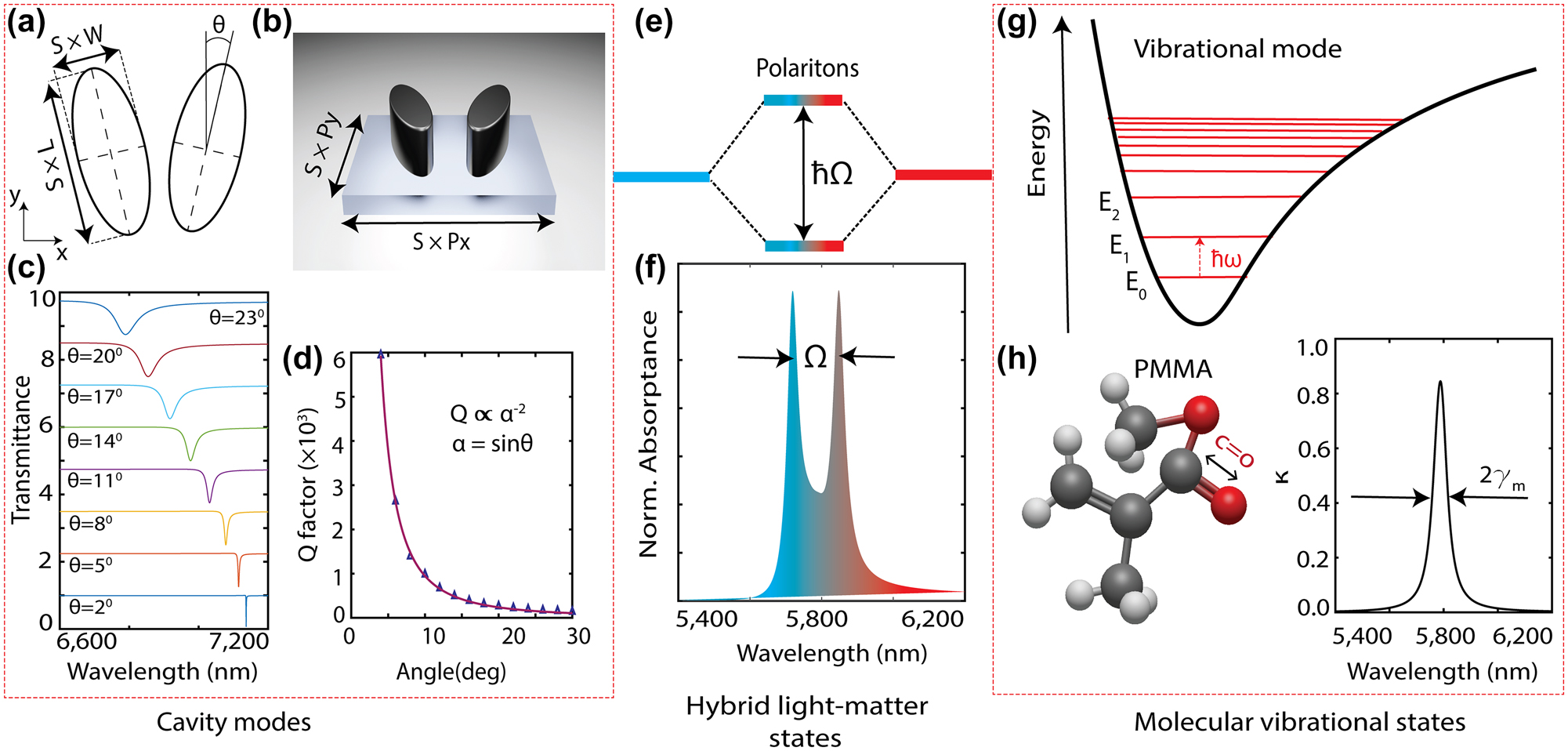
Overview of vibrational strong coupling between a photonic cavity mode and molecular vibrational states. (a and b) Top-view schematic and a rendered image of the metaunit, consisting of two elliptical dielectric structures made of germanium (Ge). The metaunit lies in the x–y plane with period Px = 4050 nm, Py = 2340 nm, L = 1077 nm, and W = 500 nm, representing the long and short axes of the elliptical disks. Scaling parameter S and asymmetry parameter θ tune the resonance wavelength and Q-factor, respectively. (c) Numerically simulated metasurface transmission spectra as a function of the asymmetry parameter θ. (d) Q-factor of the q-BIC modes as a function of the asymmetry parameter θ, revealing adjustability of the photon lifetimes. The solid red line and blue triangles represent the fitted and calculated Q factors, respectively. (e) Vibro-polaritonic states distinctly separated by the splitting energy (ℏΩ). (f) Absorption spectra illustrating the formation of splitting under strong coupling. (g) A schematic energy level diagram depicting the molecular vibrational states. (h) The chemical structure of polymethyl methacrylate (PMMA) molecule and its extinction coefficient, corresponding to C=O stretching of its carboxyl group.
2 Results
2.1 Spectral characterization of VSC
Figure 1a and b depict schematics of the studied metasurface structure, consisting of a zigzag array of Ge elliptical rods on a CaF2 substrate. In our investigations, we used a Ge metasurface as it has previously been used for VSC [37]; however, our results also apply to other dielectric metasurfaces, such as Si due to its low loss in the MIR, as demonstrated recently [40]. In this metasurface design, an asymmetry is introduced by tilting the two rods in a metaunit oppositely by θ degrees from their long vertical axes, which align with y-axis at θ = 0 degrees. Thus, the induced in-plane asymmetry disrupts the ideal BIC condition and opens coupling channels to excite the q-BIC modes with horizontally polarized and normally incident plane waves. Since Ge is a low-loss material in the MIR, the radiation losses, which are controlled by the tilting angle, θ, determine the cavity linewidth. Figure 1c and d shows the typical inverse quadratic dependence of the cavity Q-factor of q-BIC modes to the asymmetry parameter, θ.
Moreover, spectral tunability is achieved via a dimension scaling factor, S. In this work, we performed electromagnetic simulations using a finite-element frequency-domain solver (CST Studio Suite 2023) with Floquet periodic boundary conditions to study the light–matter interactions on the q-BIC metasurface. The optical constants for the Ge and CaF2 were taken from Ref. [41], [42].
The coherent dynamics of a molecule-cavity system can be modeled as two harmonic oscillators interacting with a coupling strength of g. When the complex frequencies of molecule (ω m − iγ m ) and cavity (ω c − iγ c ) are considered to account for the damping processes, the eigenfrequencies of the coupled system can be stated as in equation (1).
where δ = ω c − ω m is the detuning between cavity resonance and molecular vibration modes, and γ c and γ m are the cavity and material linewidths, respectively [43], [44]. At nonzero detuning (δ ≠ 0), the splitting, defined as the difference between the eigenfrequencies, can be expressed as in equation (2).
At the zero detuning resonance case (δ = 0), the difference between the eigenfrequencies becomes equation (3) and known as Rabi splitting, which takes real values when
In this work, to study the resonant light–matter interactions, we spectrally sweep the q-BIC resonance by changing the S parameter through the molecular vibration mode of the PMMA molecule (Figure 2). Figure 2a demonstrates the impact of spectral detuning (δ) within the coupled system. When δ is nonzero, the hybrid mode frequencies, ω
±, exhibit asymmetry across the molecular vibration mode, and the anticrossing feature appears (Figure 2c), which is a requisite for the strong coupling. At zero detuning (δ = 0), the coupled system is characterized by the Rabi splitting
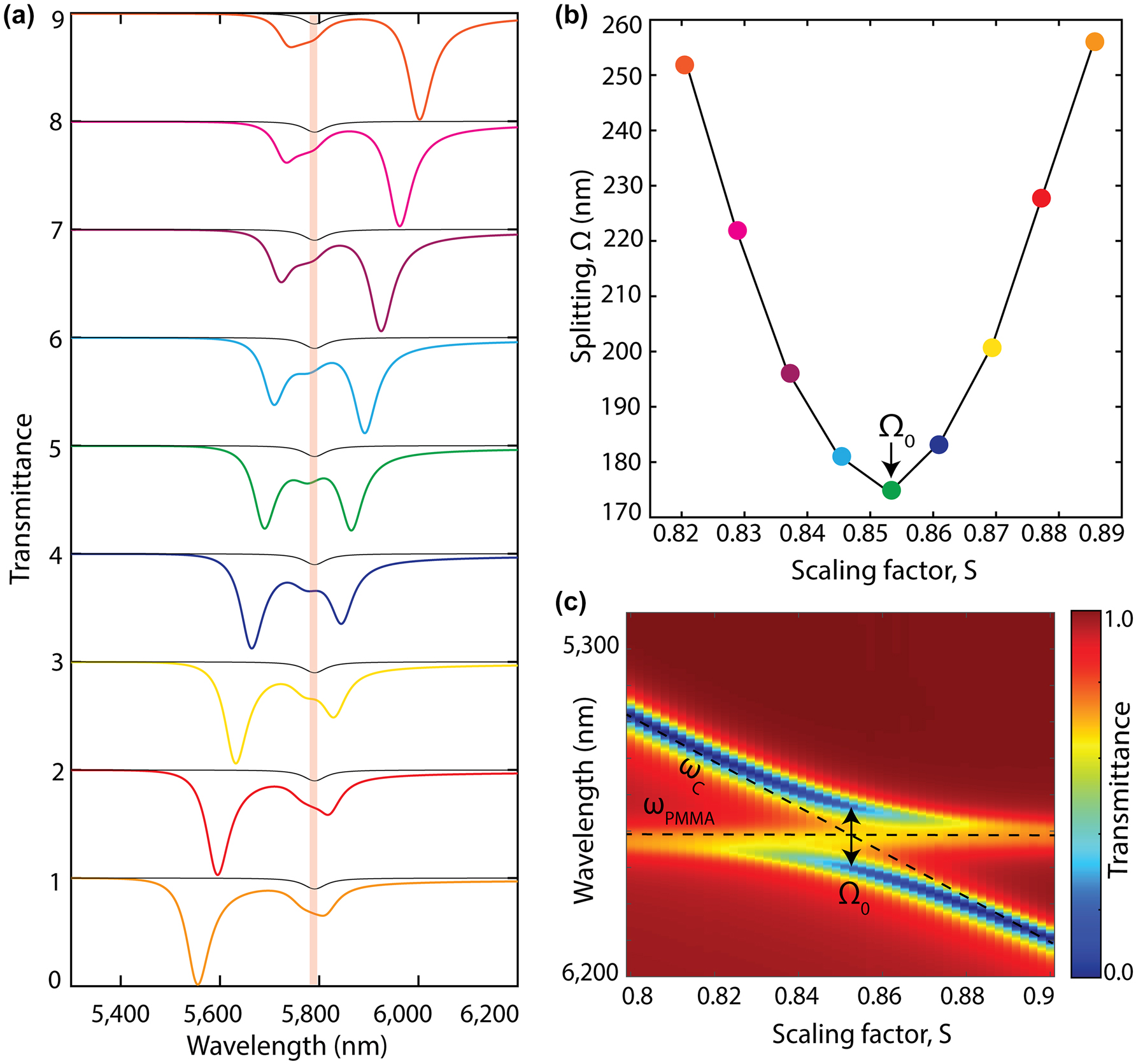
Spectral detuning between cavity resonance and molecular vibration transition mode. (a) Numerically simulated transmission spectra of a coupled system at various detuning where q-BIC metasurface cavity (θ = 20°) resonance is spectrally swept through 50 nm PMMA’s C=O absorption peak at 5780 nm resonance wavelength by varying the metasurface scaling factor, S. The transmission spectra of 50 nm PMMA layer without the metasurface is shown with the gray line. (b) Splitting, Ω, between the hybrid modes (ω ±) as a function of metasurface scaling parameter, S, where Ω0 marks the splitting at the zero-detuning (Rabi splitting). (c) Transmission spectra of the coupled system, numerically calculated by varying the metasurface scaling factor, S, reveal the hybrid mode anticrossing feature of the VSC. The uncoupled molecule’s vibrational frequency, ω PMMA , and cavity resonance mode, ω c , are individually marked with black dashed lines.
2.2 Cavity linewidth and material thickness
The coupling constant between a single two-level vibrational transition system and a cavity is defined by g
0 = μ·E
c
, where μ is molecule’s transition dipole moment and E
c
is the cavity vacuum electric field. According to this relation, the cavities that can better localize and enhance the density of states in a cavity can more efficiently couple to molecular transitions. Moreover, when more than N molecules couple to the same cavity resonance, the collective coherence between the molecular ensemble and the cavity increases by a factor of
To evaluate the ensemble molecule (N) effect on the coupling strength, we calculated the Rabi splitting as a function of PMMA material thickness on a metasurface. By varying the PMMA layer thickness (t = 3, 5, 10, 20, 30, and 50 nm), we controlled the total number of molecules (N) within a single cavity. Moreover, we repeated this study for three different q-BIC modes with varying cavity linewidths, γ
c
= 8.2, 30, and 56.7 nm, achieved by increasing the tilting angle, θ = 10, 20, and 30°, respectively (Figure 3). On the right column of Figure 3a–c, we plot the Rabi splitting values calculated for each material thickness. The findings depicted in Figure 3 demonstrate the
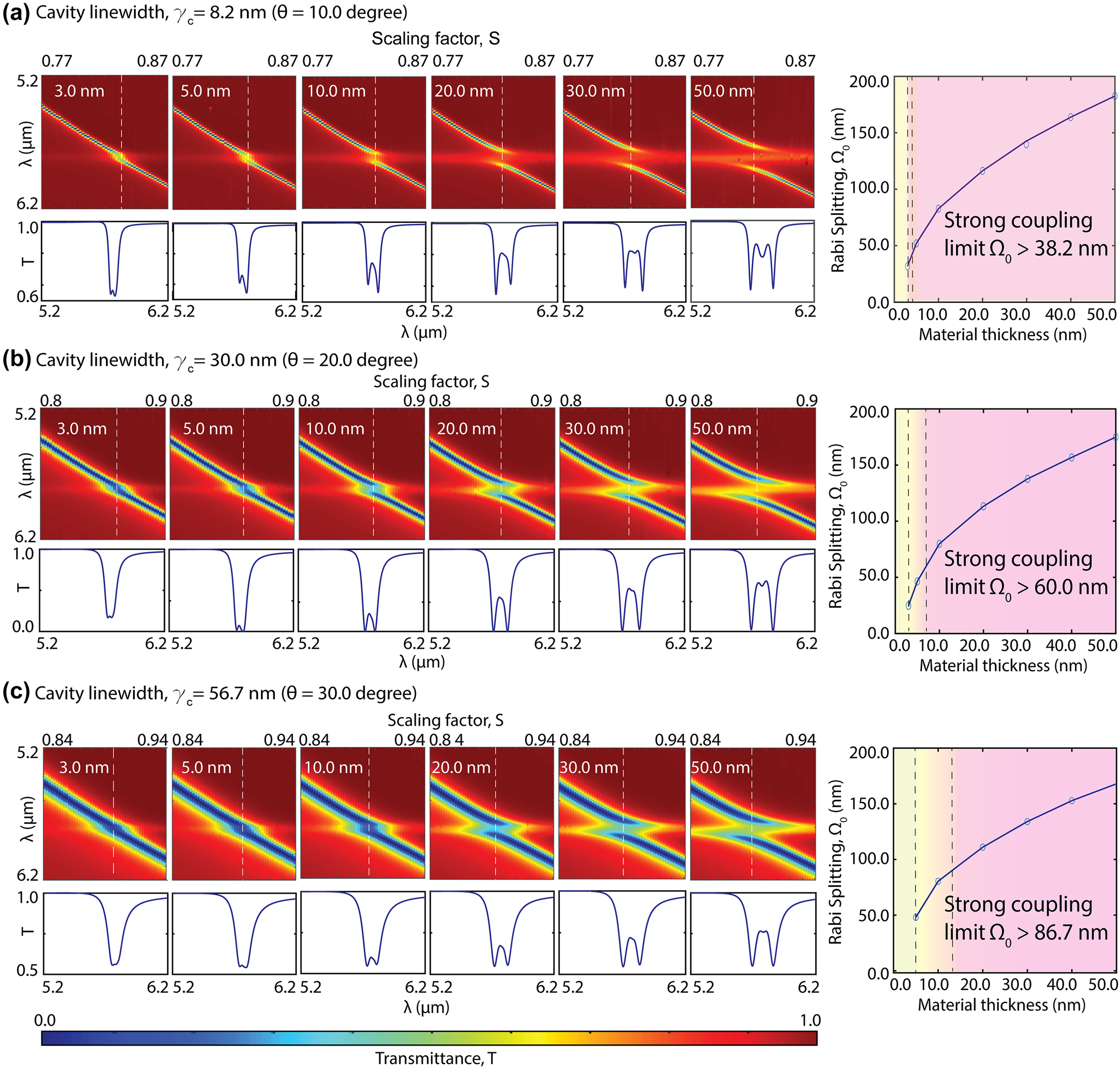
Effects of cavity linewidth and material thickness on the coupled system. The material thickness effect is shown for three different cavity linewidths with (a) γ c = 8.2 nm achieved by θ = 10°, (b) γ c = 30 nm achieved by θ = 20°, and (c) γ c = 56.7 nm achieved by θ = 30°. For each cavity linewidth, the transmission spectral maps as a function of scaling factor (i.e., various detuning), S, are presented for different PMMA layer thicknesses (3.0 nm, 5.0 nm, 10.0 nm, 20.0 nm, 30.0 nm, and 50.0 nm), showing the anticrossing patterns. Under each spectral map, a single transmission spectrum, T, at zero detuning point is shown. The white dashed lines indicate the zero detuning points for each coupled system. On the right column, plots show the Rabi splitting at the zero detuning, Ω0, as a function of material thickness. From (a) to (c), as the metasurface cavity linewidth increases, the weak-to-strong coupling transition shifts to higher material thicknesses, indicating the requirement of a larger number of collectively coupled molecules (N) for VSC to compensate for the cavity’s photon loss. The newly defined transition region is demonstrated with yellow and yellow-to-pink transition colors, and the strong coupling regime is indicated by pink color.
Notably, the coupling strength signified by the Rabi splitting versus the material thickness relation is not identical in cavities with different photon damping characteristics (Figure 3a–c). We calculated the strong coupling criteria for each cavity linewidth, γ
c
= 8.2, 30, and 56.7 nm, with Ω0 > 38.2 nm, 60.0 nm, and 86.7 nm, respectively. Our investigation in Figure 3 revealed that the minimum material thickness required to satisfy the strong coupling condition increases with the cavity linewidth, associated with the total cavity photon losses. The simulation results in Figure 3a shows that the strong coupling condition can be satisfied with as thin as 3 nm PMMA when the q-BIC mode is sharp with 8.2 nm linewidth. However, an increase in material thickness is necessary to achieve strong coupling when the cavity linewidth increases from 8.2 nm to 30.0 nm and 60.0 nm. With the higher loss cavities (larger γ
c
), when the total molecule number (N) is low, the ensemble coupling strength (g) is not sufficient for strong coupling, and the light–matter interactions are characterized under the weak coupling condition (
However, the transition between weak and strong coupling is usually not abrupt. Therefore, here, we define a new “transition coupling region,” where the polaritons can be observed in the spectrum as the Rabi frequency has a real but small value (
2.3 Material parameters
To reveal the dependency of the VSC on the molecular vibrational resonance properties, we studied various artificial materials, which are derived from the C=O bond stretching resonance in the PMMA molecule (PMMA linewidth ∼50 nm). The complex permittivity of these materials is calculated using the Lorentz model for dispersion in dielectrics [46]:
where ɛ ∞ is the background relative permittivity, f 0 is the Lorentz resonance frequency, Δɛ is the absorbance strength coefficient, and γ m the Lorentz damping rate of the molecule. Some realistic parameter values used to model the artificial materials are provided in Tables 1 and 2. Coupling the designated materials to the q-BIC cavities allowed us to study correlations between Rabi energy exchange rate and materials’ absorption strength and nonradiative losses. In IR absorption spectroscopy, the amplitude of absorption depends on the polarity of the bond, as well as the concentration of the bonds in a molecule. Therefore, the same functional group can have different absorption strengths (Δɛ) depending on the molecule. Moreover, when collecting IR spectra from a compound in liquid or solid phase, many individual molecules interact with each other. Thus, individual bond absorptions occur at varying frequencies, broadening the absorption peaks at different levels. The dephasing due to electron–phonon interactions can be reduced by cooling the sample to cryogenic temperatures, which can reduce material loss (γ m ). In our strong coupling investigations, we consider these realistic material properties to interrogate each designated material’s cavity-coupled interactions.
Lorentz oscillator parameters used to design three artificial materials with different absorption strength Δɛ with the same damping rates γ m . The imaginary parts of the permittivity for the three designated materials are plotted around the resonance frequency (f 0), showing the characteristic Lorentzian spectral line shape with fixed linewidth.
| # | ɛ ∞ | γ m (THz) | f 0 (THz) | Δɛ |
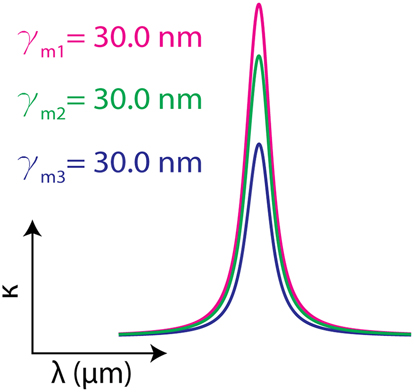
|
| 1 | 2.198 | 0.235 | 51.77 | 0.025 | |
| 2 | 2.198 | 0.235 | 51.77 | 0.050 | |
| 3 | 2.198 | 0.235 | 51.77 | 0.070 |
Lorentz oscillator parameters used to design three artificial materials with different damping rates γ m while keeping their absorption strengths Δɛ the same. The imaginary parts of the permittivity for the three designated materials are plotted around the resonance frequency (f 0), showing the characteristic Lorentzian spectral line shape with varying linewidth.
| # | ɛ ∞ | γ m (THz) | f 0 (THz) | Δɛ |
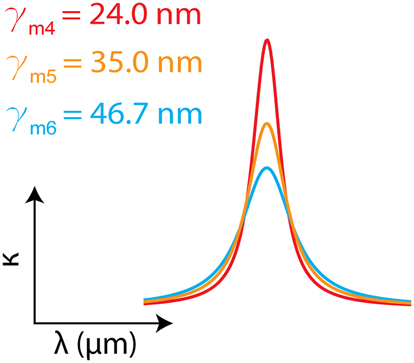
|
| 4 | 2.198 | 0.10 | 51.77 | 0.009 | |
| 5 | 2.198 | 0.15 | 51.77 | 0.009 | |
| 6 | 2.198 | 0.20 | 51.77 | 0.009 |
In Figure 4, we present our findings on the coupling strength as a function of material properties and the cavity linewidth. Figure 4a shows the Rabi splitting for three materials with different absorption strengths (Δɛ) and the same damping rates (γ
m
) as a function of the cavity linewidths (γ
c
= 10–50 nm) that they couple to. Since the absorbance peak is associated with the molecule’s transition dipole moment (μ), which determines the coupling constant (
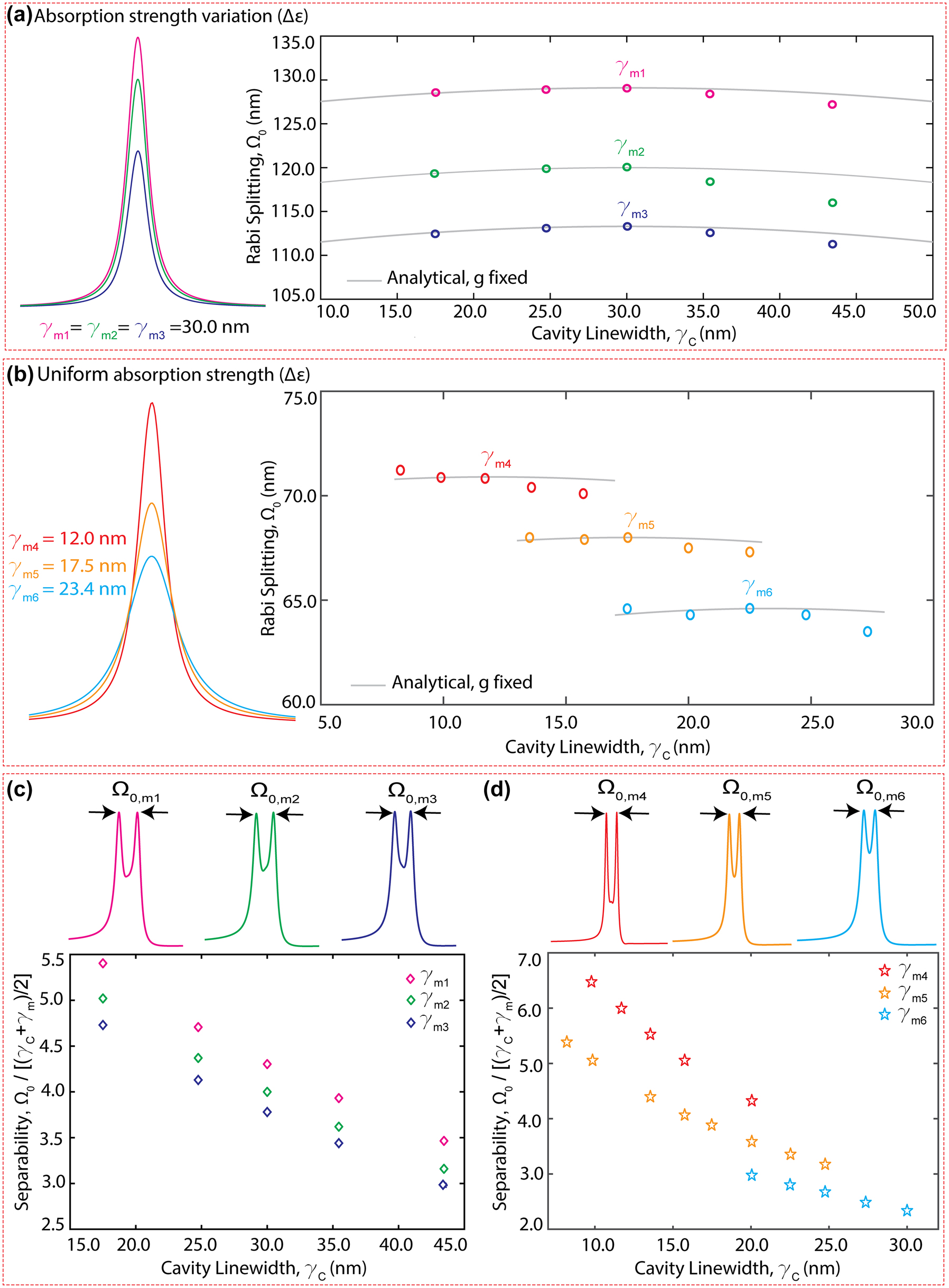
Effects of material loss and absorption strength on the coupled system. (a) Numerically calculated Ω0 as a function of cavity linewidth, γ c , for three different materials with the same absorption linewidth but different absorption strength. (b) Numerically calculated Ω0 as a function of cavity linewidth, γ c for three different materials with different damping rates but same absorption strength. The solid gray lines in (a) and (b) denote the analytical Ω0 calculated with a fixed coupling strength, g (equation (3)). Analysis of polariton peak separability as a function of cavity linewidth, γ c , observed across materials used in (a) and (b) is shown in (c) and (d), respectively. The polariton spectra with Rabi splitting Ω0,m1 to Ω0,m6 corresponding to the materials γ m1 to γ m6 at critical coupling are also shown.
Further, we analyzed the cavity linewidth effects on the separability of polariton peaks in a strongly coupled system considering the materials defined in Tables 1 and 2. Here we defined polariton separability as
2.4 Cavity-material coupling efficiency
Furthermore, we investigated the coupling strength within the hybrid system by adjusting the Q-factor of the q-BIC cavity mode. In Figure 5(a), we present Ω0 (red asterisks) values calculated by simulating a 20 nm thick PMMA with a linewidth of γ
m
= 30 nm on a q-BIC metasurface whose cavity linewidth was swept from γ
c
= 2–52 nm by varying the tilting angle, θ from 5 to 28°. The gray line shows the analytically calculated equation (3), as a function of the cavity linewidth (γ
c
), assuming a constant material damping (γ
m
) and constant coupling strength, g. The parabolic dependency of Ω0 on the cavity loss displays how the coupling efficiency reaches a local maximum when the critical coupling (γ
c
= γ
m
) condition is satisfied and how the loss mismatch between the cavity and the material decreases the coupling efficiency. The discrepancy between the simulation (red asterisk) versus analytical (gray line) results underscores γ
c
, affects
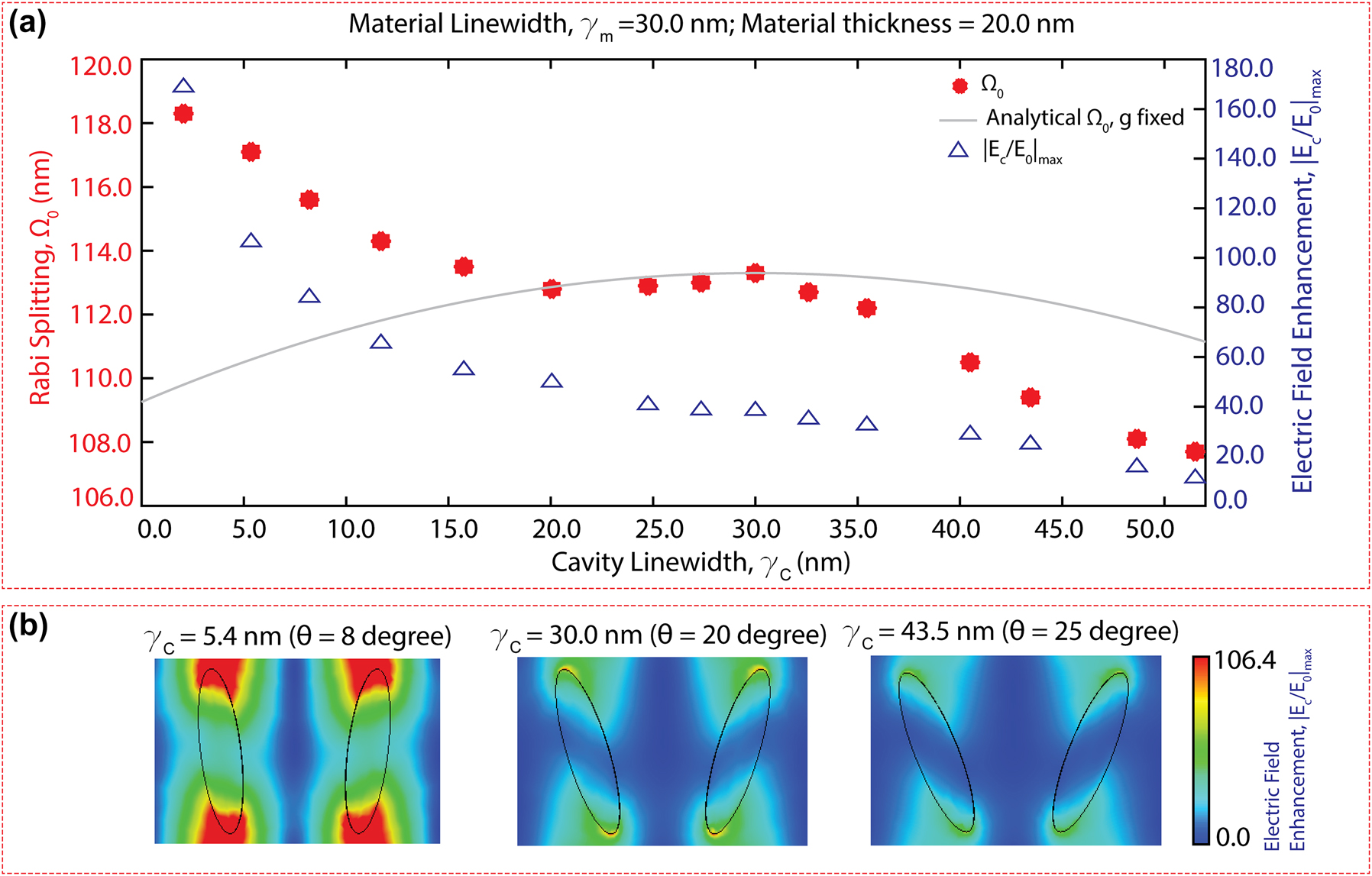
Critical strong coupling and cavity loss effects on the light–matter interactions. (a) For the same material type and thickness, the calculated Ω0 (denoted by red asterisk) is plotted as a function of cavity linewidth, γ c . The gray line shows the analytically calculated Rabi splitting as a function of γ c , assuming a constant coupling strength, g (equation (3)). The maximum field enhancement indicated by the blue triangles is plotted as a function of γ c . (b) The electric field enhancement maps for three different metasurface cavities are depicted with reference to the same color bar.
Finally, we explored the critical coupling effects for different material-cavity systems. Figure 6 shows the Rabi splitting (Ω0) variation as a function of cavity linewidth (γ c = 5–30 nm) for three different materials (γ m = 12.0 nm, 17.5 nm, and 26.0 nm). Our results reveal that it is favorable to work with ultrahigh-Q cavities to achieve strong coupling independent of the material’s vibrational transition characteristics. However, when real-world metasurface fabrication and intrinsic material losses limit the maximum achievable cavity resonance Q-factors, satisfying the critical coupling condition by cavity-material loss matching can also enhance the coupling strength (as indicated by the black arrows). This effect is specifically pronounced in materials with large absorption linewidths (see Figure 6 bottom). Overall, Figure 6 unveils how the Q-factor tunability of q-BIC cavities supported by resonant dielectric metasurface is important for VSC applications.
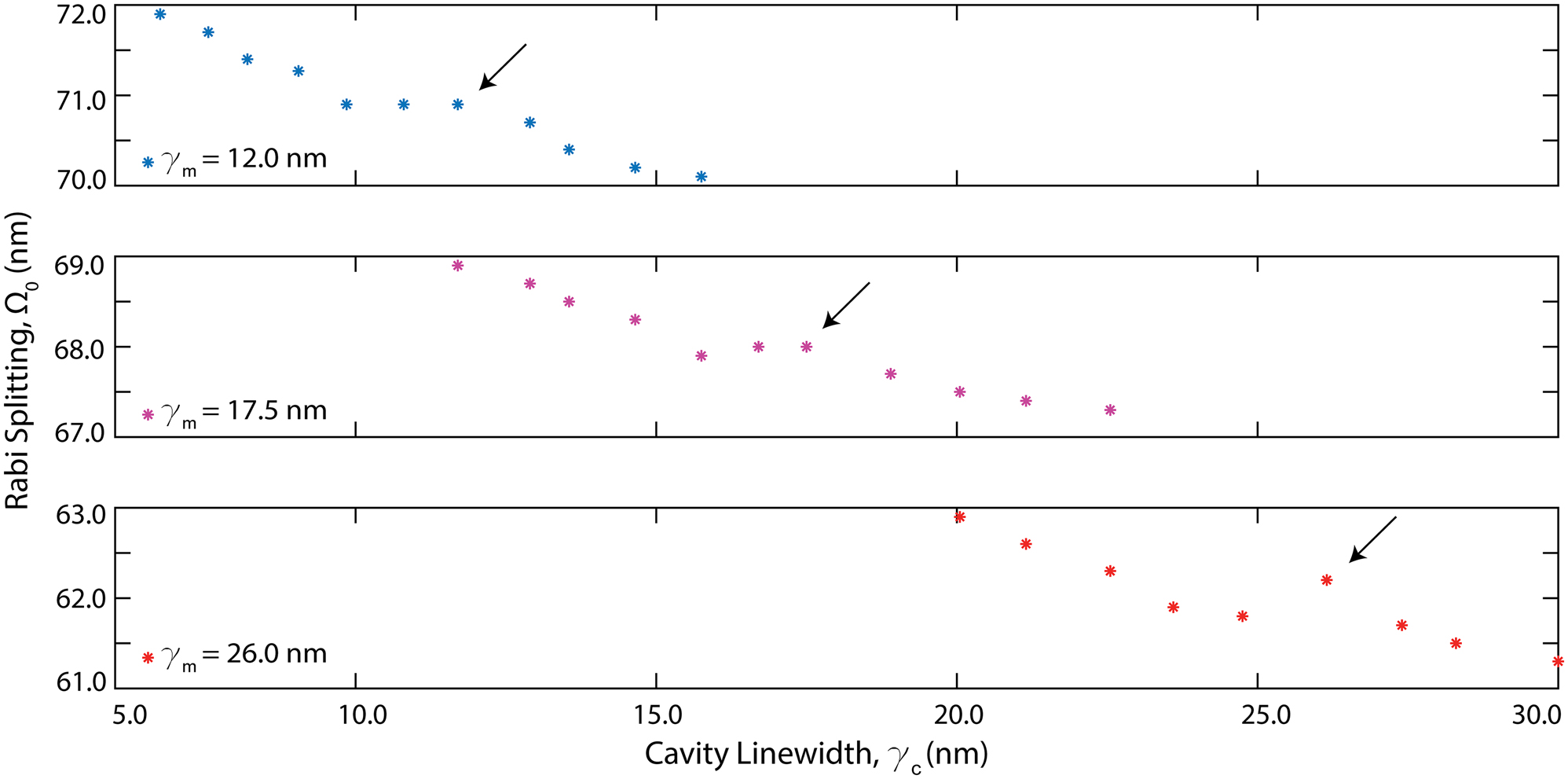
Critical strong coupling and material loss effects on the light–matter interactions. Rabi splitting as a function of cavity linewidth plotted for three different materials. As the material loss decreases (γ m = 26 nm to γ m = 12 nm), critical strong coupling shift toward the high-Q cavity region, causing an increase in coupling strength, g, and boosting the Ω0. Further boost of Ω0 is also achieved at critical coupling as shown with the black arrows.
3 Discussion
This work was initially motivated by the two published prominent reports using similar dielectric metasurface supporting the q-BIC resonance modes based on the zigzag geometry. In the work by Tittl et al., the light–matter interactions in the weak coupling regime were leveraged for biochemical sensing of proteins and polymer layers [11]. Meanwhile, Sun et al. experimentally demonstrated strong vibrational coupling with PMMA layers using similar metasurfaces [37]. Therefore, to elucidate the underlying physical parameters that determine the light–matter interaction regime, in this work, we extensively investigated the resonant cavity parameters of the zigzag metasurface design, such as the Q-factor (tuned by the symmetry-breaking factor, θ) and spectral position of the resonance (tuned by the scaling factor, S). We also considered material parameters, such as the absorption bandwidth related to the molecules’ dephasing and internal losses, transition dipole moment strength, and material thickness filling the cavity void. Our findings unveiled that as the metasurface Q-factor increases, the minimum number of molecules in a single cavity (material layer thickness on a metasurface) requirement for VSC decreases. This collective molecule-cavity coupling effect explains the weak coupling regime in Tittl et al., where thin protein monolayers were measured, and the strong coupling regime in Sun et al., where 10 s of nm thick polymer layers were measured [37].
Moreover, previous VSC investigations mainly used photonic cavities where the cavity photon loss rates were dominantly imposed by the cavity materials, specifically metals’ ohmic losses, such as in the FP and plasmonic cavities. Therefore, the effects of the photonic cavity’s Q-factor on the light–matter interactions were mostly unexplored in the MIR. Recently, all-dielectric metasurface introduced unprecedented efficiency in photon trapping into nanocavities, diminishing the limitations of cavity loss. Notably, metasurface supporting the q-BIC modes enabled the precise control of cavity photon loss rates into radiation channels via the geometrically tunable in-plane asymmetry parameters. Thus, in this work, we outlined the benefits of cavity Q-factor tunability on the light–matter coupling efficiency.
As a rule of thumb, when using dielectric metasurface for VSC applications, the first goal must be to minimize the metasurface material and radiation losses to maximize the cavity Q-factor, which increases the resonance field enhancement and thus the coupling constant, g. However, in real-world applications, metasurface fabrication imperfections, together with nonzero material loss rates, constrain the practically achievable cavity Q-factors. Then, a second important criterion for VSC and efficient light–matter interactions is the material and cavity loss matching. Uniquely, dielectric metasurface can enable critical strong coupling conditions via their Q-factor tunability. It is also noteworthy that the arguments we presented regarding Q-factor and coupling strength applies only to structures where their Q-factor is directly related to their mode volume size. Structures such as Distributed Bragg Reflectors (DBR) can also present high Q-factors, yet with relatively large mode volumes. Moreover, in the case of DBR, the field enhancement region is contained within the structure and thus limits mode interaction with target molecules.
Generally, strong coupling is defined based on the Rabi splitting exceeding the system loss rate, enabling coherent energy exchange between the cavity and the molecule. However, the literature has been ambiguous on the quantitative limits of the strong coupling regime. In this work, we adhered to the condition where the exchange rate must exceed the average loss of the two coupled oscillators (
4 Conclusions
In this work, we used CST simulation tools and coupled oscillator theory to numerically and analytically explore the cavity-coupled light–matter interactions on q-BIC metasurface. We comprehensively outlined the parameter space vital for the understanding of the coupling between resonant cavity modes and resonant vibrational transitions in molecules. We leveraged the geometrical Q-factor and spectral position tunability of the q-BIC resonances to identify the weak and strong coupling regimes, providing a deeper insight into the interaction dynamics within the coupled system. Our findings indicate that, to satisfy the VSC condition in lossy cavities, collective mode coupling to a metasurface resonance is necessary, and minimum number of required molecules for VSC increases as the cavity Q-factor decreases. Notably, we introduced a new transition light–matter coupling zone, which falls in between the weak and strong coupling extents, where polaritons form, but their linewidth prohibits their spectral identification. Moreover, we studied molecules’ transition dipole strength, absorption bandwidth correlated to their internal loss, and the total number of molecules coupled to a single cavity, to gauge their individual effects on the light–matter interactions. Our results can provide clear guidelines for designing optimal dielectric metasurface for VSC applications using a broad range of molecules’ vibrational transitions. Based on our comprehensive study, we anticipate that the photonic cavities generated by dielectric metasurface can make a huge impact in the emerging field of polaritonic chemistry, where ground states and chemical reactivity of molecules can be modified.
Funding source: National Institute of Biomedical Imaging and Bioengineering
Award Identifier / Grant number: R21EB034411
Acknowledgments
F.Y. acknowledges financial support from the National Institutes of Health.
-
Research funding: F.Y. acknowledges financial support from the National Institutes of Health (grant no. R21EB034411).
-
Author contributions: All authors have accepted responsibility for the entire content of this manuscript and approved its submission.
-
Conflict of interest: Authors state no conflicts of interest.
-
Data availability: Data sharing is not applicable to this article as no datasets were generated or analyzed during the current study.
References
[1] K. Koshelev and Y. Kivshar, “Dielectric resonant metaphotonics,” ACS Photonics, vol. 8, no. 1, pp. 102–112, 2021. https://doi.org/10.1021/acsphotonics.0c01315.Suche in Google Scholar
[2] A. Krasnok, M. Caldarola, N. Bonod, and A. Alú, “Spectroscopy and biosensing with optically resonant dielectric nanostructures,” Adv. Opt. Mater., vol. 6, no. 5, p. 1701094, 2018. https://doi.org/10.1002/adom.201701094.Suche in Google Scholar
[3] S. Kruk and Y. Kivshar, “Functional meta-optics and nanophotonics governed by mie resonances,” ACS Photonics, vol. 4, no. 11, pp. 2638–2649, 2017. https://doi.org/10.1021/acsphotonics.7b01038.Suche in Google Scholar
[4] S. Yang, M. He, C. Hong, J. D. Caldwell, and J. C. Ndukaife, “Engineering electromagnetic field distribution and resonance quality factor using slotted quasi-BIC metasurfaces,” Nano Lett., vol. 22, no. 20, pp. 8060–8067, 2022. https://doi.org/10.1021/acs.nanolett.2c01919.Suche in Google Scholar PubMed
[5] C. W. Hsu, B. Zhen, A. D. Stone, J. D. Joannopoulos, and M. Soljačić, “Bound states in the continuum,” Nat. Rev. Mater., vol. 1, no. 9, p. 16048, 2016. https://doi.org/10.1038/natrevmats.2016.48.Suche in Google Scholar
[6] K. L. Koshelev, Z. F. Sadrieva, A. A. Shcherbakov, Y. S. Kivshar, and A. A. Bogdanov, “Bound states in the continuum in photonic structures,” Physics-Uspekhi, vol. 66, no. 5, pp. 494–517, 2023, https://doi.org/10.3367/ufne.2021.12.039120.Suche in Google Scholar
[7] K. Koshelev, S. Lepeshov, M. Liu, A. Bogdanov, and Y. Kivshar, “Asymmetric metasurfaces with high-Q resonances governed by bound states in the continuum,” Phys. Rev. Lett., vol. 121, no. 19, p. 193903, 2018. https://doi.org/10.1103/PhysRevLett.121.193903.Suche in Google Scholar PubMed
[8] Y. Shi, et al.., “Multifunctional virus manipulation with large-scale arrays of all-dielectric resonant nanocavities,” Laser Photon. Rev., vol. 16, no. 5, p. 2100197, 2022. https://doi.org/10.1002/lpor.202100197.Suche in Google Scholar
[9] F. Yesilkoy, et al.., “Ultrasensitive hyperspectral imaging and biodetection enabled by dielectric metasurfaces,” Nat. Photonics, vol. 13, no. 6, pp. 390–396, 2019. https://doi.org/10.1038/s41566-019-0394-6.Suche in Google Scholar
[10] S. Romano, et al.., “Ultrasensitive surface refractive index imaging based on quasi-bound states in the continuum,” ACS Nano, vol. 14, no. 11, pp. 15417–15427, 2020. https://doi.org/10.1021/acsnano.0c06050.Suche in Google Scholar PubMed
[11] A. Tittl, et al.., “Imaging-based molecular barcoding with pixelated dielectric metasurfaces,” Science, vol. 360, no. 6393, pp. 1105–1109, 2018. https://doi.org/10.1126/science.aas9768.Suche in Google Scholar PubMed
[12] S. Han, P. Pitchappa, W. Wang, Y. K. Srivastava, M. V. Rybin, and R. Singh, “Extended bound states in the continuum with symmetry-broken terahertz dielectric metasurfaces,” Adv. Opt. Mater., vol. 9, no. 7, p. 2002001, 2021. https://doi.org/10.1002/adom.202002001.Suche in Google Scholar
[13] J. Lou, et al.., “Calibration-free, high-precision, and robust terahertz ultrafast metasurfaces for monitoring gastric cancers,” Proc. Natl. Acad. Sci. U. S. A., vol. 119, no. 43, 2022, Art. no. e2209218119. https://doi.org/10.1073/pnas.2209218119.Suche in Google Scholar PubMed PubMed Central
[14] G. Zograf, et al.., “High-harmonic generation from resonant dielectric metasurfaces empowered by bound states in the continuum,” ACS Photonics, vol. 9, no. 2, pp. 567–574, 2022. https://doi.org/10.1021/acsphotonics.1c01511.Suche in Google Scholar
[15] Z. Liu, J. Wang, B. Chen, Y. Wei, W. Liu, and J. Liu, “Giant enhancement of continuous wave second harmonic generation from few-layer GaSe coupled to high-Q quasi bound states in the continuum,” Nano Lett., vol. 21, no. 17, pp. 7405–7410, 2021. https://doi.org/10.1021/acs.nanolett.1c01975.Suche in Google Scholar PubMed
[16] L. Liu, R. Wang, Y. Sun, Y. Jin, and A. Wu, “Fluorescence enhancement of PbS colloidal quantum dots from silicon metasurfaces sustaining bound states in the continuum,” Nanophotonics, vol. 12, no. 15, pp. 3159–3164, 2023. https://doi.org/10.1515/nanoph-2023-0195.Suche in Google Scholar
[17] Y.-T. Lin, A. Hassanfiroozi, W.-R. Jiang, M.-Y. Liao, W.-J. Lee, and P. C. Wu, “Photoluminescence enhancement with all-dielectric coherent metasurfaces,” Nanophotonics, vol. 11, no. 11, pp. 2701–2709, 2022. https://doi.org/10.1515/nanoph-2021-0640.Suche in Google Scholar
[18] T. Shi, et al.., “Planar chiral metasurfaces with maximal and tunable chiroptical response driven by bound states in the continuum,” Nat. Commun., vol. 13, no. 1, p. 4111, 2022. https://doi.org/10.1038/s41467-022-31877-1.Suche in Google Scholar PubMed PubMed Central
[19] Y. Kim, A. Barulin, S. Kim, L. P. Lee, and I. Kim, “Recent advances in quantum nanophotonics: plexcitonic and vibro-polaritonic strong coupling and its biomedical and chemical applications,” Nanophotonics, vol. 12, no. 3, pp. 413–439, 2023. https://doi.org/10.1515/nanoph-2022-0542.Suche in Google Scholar
[20] V. A. Yakovlev, V. G. Nazin, and G. N. Zhizhin, “The surface polariton splitting due to thin surface film LO vibrations,” Opt. Commun., vol. 15, no. 2, pp. 293–295, 1975. https://doi.org/10.1016/0030-4018(75)90306-5.Suche in Google Scholar
[21] J. D. Plumhof, T. Stöferle, L. Mai, U. Scherf, and R. F. Mahrt, “Room-temperature Bose–Einstein condensation of cavity exciton–polaritons in a polymer,” Nat. Mater., vol. 13, no. 3, pp. 247–252, 2014. https://doi.org/10.1038/nmat3825.Suche in Google Scholar PubMed
[22] R. Chikkaraddy, et al.., “Single-molecule strong coupling at room temperature in plasmonic nanocavities,” Nature, vol. 535, no. 7610, pp. 127–130, 2016. https://doi.org/10.1038/nature17974.Suche in Google Scholar PubMed PubMed Central
[23] K. Santhosh, O. Bitton, L. Chuntonov, and G. Haran, “Vacuum Rabi splitting in a plasmonic cavity at the single quantum emitter limit,” Nat. Commun., vol. 7, no. 1, 2016, Art. no. ncomms11823. https://doi.org/10.1038/ncomms11823.Suche in Google Scholar PubMed PubMed Central
[24] T. Weber, et al.., “Intrinsic strong light-matter coupling with self-hybridized bound states in the continuum in van der Waals metasurfaces,” Nat. Mater., vol. 22, no. 8, pp. 970–976, 2023. https://doi.org/10.1038/s41563-023-01580-7.Suche in Google Scholar PubMed PubMed Central
[25] A. Amo, et al.., “Superfluidity of polaritons in semiconductor microcavities,” Nat. Phys., vol. 5, no. 11, pp. 805–810, 2009. https://doi.org/10.1038/nphys1364.Suche in Google Scholar
[26] J. P. Long and B. S. Simpkins, “Coherent coupling between a molecular vibration and Fabry–Perot optical cavity to give hybridized states in the strong coupling limit,” ACS Photonics, vol. 2, no. 1, pp. 130–136, 2015. https://doi.org/10.1021/ph5003347.Suche in Google Scholar
[27] J. George, A. Shalabney, J. A. Hutchison, C. Genet, and T. W. Ebbesen, “Liquid-phase vibrational strong coupling,” J. Phys. Chem. Lett., vol. 6, no. 6, pp. 1027–1031, 2015. https://doi.org/10.1021/acs.jpclett.5b00204.Suche in Google Scholar PubMed
[28] A. Shalabney, J. George, J. Hutchison, G. Pupillo, C. Genet, and T. W. Ebbesen, “Coherent coupling of molecular resonators with a microcavity mode,” Nat. Commun., vol. 6, no. 1, p. 5981, 2015. https://doi.org/10.1038/ncomms6981.Suche in Google Scholar PubMed PubMed Central
[29] R. M. A. Vergauwe, et al.., “Quantum strong coupling with protein vibrational modes,” J. Phys. Chem. Lett., vol. 7, no. 20, pp. 4159–4164, 2016. https://doi.org/10.1021/acs.jpclett.6b01869.Suche in Google Scholar PubMed
[30] H. Memmi, O. Benson, S. Sadofev, and S. Kalusniak, “Strong coupling between surface plasmon polaritons and molecular vibrations,” Phys. Rev. Lett., vol. 118, no. 12, p. 126802, 2017. https://doi.org/10.1103/PhysRevLett.118.126802.Suche in Google Scholar PubMed
[31] K. S. Menghrajani, G. R. Nash, and W. L. Barnes, “Vibrational strong coupling with surface plasmons and the presence of surface plasmon stop bands,” ACS Photonics, vol. 6, no. 8, pp. 2110–2116, 2019. https://doi.org/10.1021/acsphotonics.9b00662.Suche in Google Scholar PubMed PubMed Central
[32] D. Yoo, et al.., “Ultrastrong plasmon–phonon coupling via epsilon-near-zero nanocavities,” Nat. Photonics, vol. 15, no. 2, pp. 125–130, 2021. https://doi.org/10.1038/s41566-020-00731-5.Suche in Google Scholar
[33] M. Hertzog, B. Munkhbat, D. Baranov, T. Shegai, and K. Börjesson, “Enhancing vibrational light–matter coupling strength beyond the molecular concentration limit using plasmonic arrays,” Nano Lett., vol. 21, no. 3, pp. 1320–1326, 2021. https://doi.org/10.1021/acs.nanolett.0c04014.Suche in Google Scholar PubMed PubMed Central
[34] G. Dayal, I. Morichika, and S. Ashihara, “Vibrational strong coupling in subwavelength nanogap patch antenna at the single resonator level,” J. Phys. Chem. Lett., vol. 12, no. 12, pp. 3171–3175, 2021. https://doi.org/10.1021/acs.jpclett.1c00081.Suche in Google Scholar PubMed
[35] B. Cohn, K. Das, A. Basu, and L. Chuntonov, “Infrared open cavities for strong vibrational coupling,” J. Phys. Chem. Lett., vol. 12, no. 29, pp. 7060–7066, 2021. https://doi.org/10.1021/acs.jpclett.1c01438.Suche in Google Scholar PubMed
[36] E. A. Muller, et al.., “Nanoimaging and control of molecular vibrations through electromagnetically induced scattering reaching the strong coupling regime,” ACS Photonics, vol. 5, no. 9, pp. 3594–3600, 2018. https://doi.org/10.1021/acsphotonics.8b00425.Suche in Google Scholar PubMed PubMed Central
[37] K. Sun, M. Sun, Y. Cai, U. Levy, and Z. Han, “Strong coupling between quasi-bound states in the continuum and molecular vibrations in the mid-infrared,” Nanophotonics, vol. 11, no. 18, pp. 4221–4229, 2022. https://doi.org/10.1515/nanoph-2022-0311.Suche in Google Scholar
[38] P. Xie and Y. Cheng, “Manipulating coherent interaction of molecular vibrations with quasibound states in the continuum in all-dielectric metasurfaces,” Phys. Rev. B, vol. 108, no. 15, p. 155412, 2023. https://doi.org/10.1103/PhysRevB.108.155412.Suche in Google Scholar
[39] P. Xie, et al.., “Tunable interactions of quasibound states in the continuum with cavity mode in a metasurface-microcavity hybrid,” Phys. Rev. B, vol. 106, no. 16, p. 165408, 2022. https://doi.org/10.1103/PhysRevB.106.165408.Suche in Google Scholar
[40] W. Adi, S. Rosas, A. Beisenova, S. K. Biswas, and F. Yesilkoy, “Trapping light in air with membrane metasurfaces for vibrational strong coupling”, arXiv, 2024. https://doi.org/10.48550/arXiv.2402.17901.Suche in Google Scholar
[41] J. H. Burnett, S. G. Kaplan, E. Stover, and A. Phenis, “Refractive index measurements of Ge,” in Infrared Sensors, Devices, and Applications VI, vol. 9974, San Diego, California, United States, SPIE, 2016, pp. 222–232.10.1117/12.2237978Suche in Google Scholar
[42] H. H. Li, “Refractive index of alkaline earth halides and its wavelength and temperature derivatives,” J. Phys. Chem. Ref. Data, vol. 9, no. 1, pp. 161–290, 1980. https://doi.org/10.1063/1.555616.Suche in Google Scholar
[43] D. G. Baranov, M. Wersäll, J. Cuadra, T. J. Antosiewicz, and T. Shegai, “Novel nanostructures and materials for strong light–matter interactions,” ACS Photonics, vol. 5, no. 1, pp. 24–42, 2018. https://doi.org/10.1021/acsphotonics.7b00674.Suche in Google Scholar
[44] L. Huang, A. Krasnok, A. Alú, Y. Yu, D. Neshev, and A. E. Miroshnichenko, “Enhanced light–matter interaction in two-dimensional transition metal dichalcogenides,” Rep. Prog. Phys., vol. 85, no. 4, p. 046401, 2022. https://doi.org/10.1088/1361-6633/ac45f9.Suche in Google Scholar PubMed
[45] M. Tavis and F. W. Cummings, “Exact solution for an N-molecule–radiation-field Hamiltonian,” Phys. Rev., vol. 170, no. 2, pp. 379–384, 1968. https://doi.org/10.1103/PhysRev.170.379.Suche in Google Scholar
[46] B. E. A. Saleh and M. C. Teich, Fundamentals of Photonics, Hoboken, NJ, John Wiley & Sons, 2019.Suche in Google Scholar
Supplementary Material
This article contains supplementary material (https://doi.org/10.1515/nanoph-2024-0043).
© 2024 the author(s), published by De Gruyter, Berlin/Boston
This work is licensed under the Creative Commons Attribution 4.0 International License.
Artikel in diesem Heft
- Frontmatter
- Review
- Nanophotonic route to control electron behaviors in 2D materials
- Research Articles
- Compact biologically inspired camera with computational compound eye
- Multistability manipulation by reinforcement learning algorithm inside mode-locked fiber laser
- Emission engineering in microdisk lasers via direct integration of meta-micromirrors
- Coherent light-emitting metasurfaces based on bound states in the continuum
- Simultaneous generation of first- to fourth-order OAM modes based on a cascaded preset-twist long-period fiber grating
- From weak to strong coupling: quasi-BIC metasurfaces for mid-infrared light–matter interactions
- Reconfigurable quantum photonic circuits based on quantum dots
- Silicon-based planar devices for narrow-band near-infrared photodetection using Tamm plasmons
- Color arrestor pixels for high-fidelity, high-sensitivity imaging sensors
- Casimir interaction driven by hyperbolic polaritons
- Metatronics-inspired high-selectivity metasurface filter
- Dyakonov surface waves in dielectric crystals with negative anisotropy
Artikel in diesem Heft
- Frontmatter
- Review
- Nanophotonic route to control electron behaviors in 2D materials
- Research Articles
- Compact biologically inspired camera with computational compound eye
- Multistability manipulation by reinforcement learning algorithm inside mode-locked fiber laser
- Emission engineering in microdisk lasers via direct integration of meta-micromirrors
- Coherent light-emitting metasurfaces based on bound states in the continuum
- Simultaneous generation of first- to fourth-order OAM modes based on a cascaded preset-twist long-period fiber grating
- From weak to strong coupling: quasi-BIC metasurfaces for mid-infrared light–matter interactions
- Reconfigurable quantum photonic circuits based on quantum dots
- Silicon-based planar devices for narrow-band near-infrared photodetection using Tamm plasmons
- Color arrestor pixels for high-fidelity, high-sensitivity imaging sensors
- Casimir interaction driven by hyperbolic polaritons
- Metatronics-inspired high-selectivity metasurface filter
- Dyakonov surface waves in dielectric crystals with negative anisotropy


